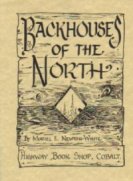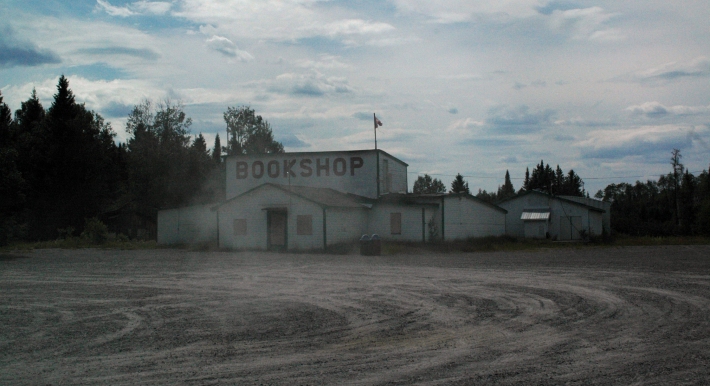Notes on the Highway Book Shop, Cobalt Ontario
In July of 2012, Conduit Canada made a brief but memorable trip to our home country. Out of nostalgic obligation, we drifted to the once-great Highway Book Shop. What we found there: a few raspberry bushes, boarded windows and a shredded Canadian flag.
 I had heard the store shut down in May 2011, but needed to see it to believe it. Indeed, the largest book store in Northern Ontario, independent small press and home to over 100 000 new and used books had folded to the great detriment of local and national literary culture. Hopefully this post can act as a preliminary resource for any academic or other researchers interested in this crucial conduit of literary activity.
I had heard the store shut down in May 2011, but needed to see it to believe it. Indeed, the largest book store in Northern Ontario, independent small press and home to over 100 000 new and used books had folded to the great detriment of local and national literary culture. Hopefully this post can act as a preliminary resource for any academic or other researchers interested in this crucial conduit of literary activity.
There are some limited print resources on the shop, specifically a coffee-table sized book by the owner’s widow, Lois Pollard. During our brief visit to Northern Ontario we found her book in a local Library thanks to the consideration of a plucky librarian. Besides this, there is practically no physical evidence of the Highway Book Shop’s vibrant history. In a landscape of well-maintained railroad museums, one of The Toronto Star’s nominated 100 Praiseworthy Things carries next to no cultural monuments.

The Highway Book Store opened in 1957 as a profit-oriented business. It began as a conventional printing company which eventually became a book retail outlet after receiving a box of books as payment for a printing job. From there, Douglas Pollard sold books until he had enough money to buy printing equipment and publish books himself. It was one of the few resources for books in Northern Ontario as a mail-order or retail outlet so it did quite well in its first two decades. As the press grew, more buildings were added onto the store which by the 2000’s resulted in a mammoth five-building property that was a testament to the growth and eventual decline of the publishing industry in the second half of the 20th century.
His business model was commendable: when Pollard turned to publishing, he balanced philanthropic and capitalistic principles. The press was mostly interested in local history and culture. As Lois Pollard’s book notes “any manuscripts having to do with the First Nations people, especially if written by someone of Native heritage were almost certain to sell well.” How-to, humour and self-help books were also preferred manuscripts because they financially balanced out the poetry and fiction titles the press published. How-to books were sensationally popular in the isolated Northern Ontario area and were relatively easy to produce, especially compared to an editorially burdensome poetry or fiction manuscript. As Douglas Pollard says concerning the work of his press and presses similar to his: “writing and compiling the history of an area is a monumental task as so much has happened that needs to be recorded. By the same token all of this history has created a printing job that was not only time consuming, but in view of today’s high costs in the printing field came at a higher cost than we would have liked” (80).
 The most noteworthy author published by the press was Muriel Newton-White, whose children’s books about rabbits Happy and Hoppy gained national recognition. Many of these books, such as its most famous “Backhouses of the North” involved successful collaboration between local artists and all of them contributed to the written history of Northern Ontario culture.
The most noteworthy author published by the press was Muriel Newton-White, whose children’s books about rabbits Happy and Hoppy gained national recognition. Many of these books, such as its most famous “Backhouses of the North” involved successful collaboration between local artists and all of them contributed to the written history of Northern Ontario culture.
Eventually Pollard produced a small magazine/newsletter to shorten the distance between local Northern Ontario writers called Writer’s Lifeline. These were valuable pieces of ephemera that provided information about local writers conferences and workshops. It also published “book reviews, articles on creative writing and all topics related to the publishing industry; contests; awards; and even writers’ games. Freelance writers could list their specialties and their contact information; and a classified section was included to help in the search for temporary and permanent personnel.” Another stated reason for starting the newsletter was Pollard felt the need to help smaller publishing houses find authors that suited their more diverse or specific publishing interests. If an author’s manuscript did not suit the publication needs of the Highway Book Shop they would be referred to another publishing house through the connections made by Writer’s Lifeline.
*
When Conduit Canada visited the shell of Highway Book Shop there was an open-air roofed area on the South wall of the buildings. Inside it were makeshift tables, old sale signs, publishing catalogs and galleys for books with titles like Hockey Days. All this ephemera survived outside in the brutal Northern Ontario winter. It appears now that even the back catalog of the Highway Book Shop press is unavailable through conventional post or online orders. The website is in a type of disarray similar to the physical state of the deceased store. There is no index of the press online but it is provided at the end of Lois Pollard’s book.
In our opinion, this book store most certainly deserves to be named a heritage site and deserves some gesture of posterity. Its former property would serve as an excellent site for a museum to North Ontario Literary Activity. Unfortunately, the transition to museum seems to be the logical conclusion to the recent timeline of used book stores.
Hopefully new resources will be uncovered in the coming months on the status of the Highway Book Shop catalog. A serious and comprehensive survey of its history is a great topic for postgraduate research. Laurentian University archives has 13 meters of records on the institution provided by Lois Pollard.
*
Cited sources/resources for further study:
-Pollard, Lois. Highway Book Shop: Northern Ontario’s Unexpected Treasure. White Mountain Publications, New Liskeard, 2011. <http://www.wmpub.ca/1033-HBS.htm>.
-Laurentian University Archives HBS Fonds: <http://www.laurentian.ca/webfm_send/868>.
-Backhouses of The North publication information: <http://www.highwaybooks.ca/150-Backhouses.htm>
-Current URL of the HBS catalog (incomplete): <http://www.highwaybooks.ca/10-00-bk.htm>.
-Durrell, Rob. “Book Review: Highway Book Shop.” Timmins Today. 20 Dec 2011. <http://www.timminstoday.com/index.php?option=com_content&task=view&id=4266>.
**All photos besides “Backhouses of the North” & “Lois Pollard” by Heather McCarthy.


